Scottish Marine and Freshwater Science Volume 6 Number 4: A Mapping Study of the Overlap of Potential Eurasian Beaver (Castor fiber) Habitat and Atlantic Salmon (Salmo salar) Distribution in Scotland
Report establishing whether there would be substantial overlap of potential beaver habitat and known Atlantic salmon distribution, should beavers be formally reintroduced to Scotland.
References
Allen, A. W. (1983). Habitat suitability index models: beaver. Western Energy and Land Use Team, Division of Biological Service, Research and Development, Fish and Wildlife Service, US Department of the Interior.
Anderson, J. T., & Bonner, J. L. (2013). Modelling Habitat Suitability for Beaver (Castor canadensis) Using Geographic Information Systems. International Proceedings of Chemical, Biological & Environmental Engineering, 61.
Anon (2014). Status of Scottish Salmon. Marine Scotland Science Report.
Armstrong, J.D. (2010). Variation in habitat quality for drift-feeding Atlantic salmon and brown trout in relation to local water velocity and river discharge. In P. Kemp: Salmonid fisheries freshwater habitat management. Wiley-Blackwell. pp 1-27.
Armstrong, J.D. & Nislow, K.H. (2006). Critical habitat during the transition from maternal provisioning in freshwater fish. With emphasis on Atlantic salmon ( Salmo salar) and brown trout ( Salmo trutta). Journal of Zoology 269, 403-413.
Collen, P. and Gibson, R.J. (2001). The general ecology of beavers ( Castor spp.), as related to their influence on stream ecosystems and riparian habitats, and the subsequent effects on fish - a review. Reviews in Fish Biology and Fisheries 10, 439-461.
Danell, K. (1996). Introductions of aquatic rodents: lessons of the muskrat Ondatra zibethicus invasion. Wildlife Biology 2, 213-220.
Dryburgh, A. (2009). The Potential Impacts of Beaver Dams on Salmon Migrations in the River Tweed Catchment, Scotland. MSc Aquatic Ecosystems Management Research Thesis (unpublished), Edinburgh Napier University, Edinburgh 56pp.
Einum, S., Nislow, K. H., McKelvey, S., & Armstrong, J. D. (2011). The spatial scale of competition from recruits on an older cohort in Atlantic salmon. Oecologia, 167(4), 1017-1025.
Elliott, J. M. (1994). Quantitative ecology and the brown trout. Oxford: Oxford University Press.
Elliott, J. M., & Hurley, M. A. (1997). A functional model for maximum growth of Atlantic salmon parr, Salmo salar, from two populations in northwest England. Functional Ecology, 11(5), 592-603.
Elmeros, M., Madsen, A. B. & Berthelsen J. P. (2003). Monitoring of reintroduced beavers ( Castor fiber) in Denmark. Lutra, 46, 153-162.
Finstad, A. G., Armstrong, J. D., & Nislow, K. H. (2010). Freshwater habitat requirements of Atlantic salmon (pp. 67-87). John Wiley & Sons, Inc.: Hoboken, NJ, USA.
Gardiner, R. and Egglishaw, H. (1986). A Map of the Distribution in Scottish Rivers of the Atlantic Salmon, Salmo salar L. Department of Agriculture and Fisheries for Scotland, Freshwater Fisheries Laboratory, Pitlochry. 5pp + folded map. Scottish Fisheries Publication.
Gauld, N. R., Campbell, R. N. B., & Lucas, M. C. (2013). Reduced flow impacts salmonid smolt emigration in a river with low-head weirs. Science of the total environment, 458, 435-443.
Gaywood, M.J. (2014). European beaver. Version 1.0. In the Species Action Framework Handbook. Gaywood, M. J., Boon, P.J., Thompson, D.B.A., & Strachan, I. (eds.). Scottish Natural Heritage, Battleby, Perth.
Gowans, A. R. D., Armstrong, J. D., Priede, I. G., & McKelvey, S. (2003). Movements of Atlantic salmon migrating upstream through a fish ‐pass complex in Scotland. Ecology of Freshwater Fish, 12(3), 177-189.
Gurney, W. S., Bacon, P. J., Tyldesley, G., & Youngson, A. F. (2008). Process-based modelling of decadal trends in growth, survival, and smolting of wild salmon ( Salmo salar) parr in a Scottish upland stream. Canadian Journal of Fisheries and Aquatic Sciences, 65(12), 2606-2622.
Hartman, G. and Törnlöv, S. (2006). Influence of watercourse depth and width on dam-building behaviour of Eurasian beaver ( Castor fiber). Journal of Zoology 268, 127-131.
Höjesjö, J., Stradmeyer, L., Griffiths, S. & Armstrong, J.D. (2010). Effects of brown trout on habitat use by Atlantic salmon parr: controlled investigations in a laboratory stream. In: P. Kemp: Salmonid fisheries freshwater habitat management. Wiley-Blackwell. pp 1-27
Jonsson, N., Jonsson, B., & Hansen, L. P. (1998). The relative role of density ‐dependent and density ‐independent survival in the life cycle of Atlantic salmon Salmo salar. Journal of Animal Ecology, 67(5), 751-762.
Kekäläinen, J., Niva, T., & Huuskonen, H. (2008). Pike predation on hatchery ‐reared Atlantic salmon smolts in a northern Baltic river. Ecology of Freshwater Fish, 17(1), 100-109.
Kemp, P.S., Worthington, T.A., Langford, T.E.L., Tree, A.R.J. and Gaywood, M.J. (2010). Qualitative and quantitative effects of reintroduced beavers on stream fish. Fish and Fisheries 13, 158-181.
Kitchener, A. (2001). Beavers. Whittet.
Maitland, P. S., & Campbell, R. N. (1992). Freshwater fishes of the British Isles (Vol. 75). Harper Collins.
Malcolm, I. A., Soulsby, C., Hannah, D. M., Bacon, P. J., Youngson, A. F., & Tetzlaff, D. (2008). The influence of riparian woodland on stream temperatures: implications for the performance of juvenile salmonids. Hydrological processes, 22(7), 968-979.
Mills, D. (1991). Ecology and management of Atlantic salmon. Springer.
Mitchell, S. C., & Cunjak, R. A. (2007). Stream flow, salmon and beaver dams: roles in the structuring of stream fish communities within an anadromous salmon dominated stream. Journal of Animal Ecology, 76(6), 1062-1074.
Museth, J., Hesthagen, T., Sandlund, O. T., Thorstad, E. B., & Ugedal, O. (2007). The history of the minnow Phoxinus phoxinus (L.) in Norway: from harmless species to pest. Journal of Fish Biology, 71(sd), 184-195.
Nislow, K. H., Folt, C. L., & Parrish, D. L. (1999). Favorable foraging locations for young Atlantic salmon: application to habitat and population restoration. Ecological Applications, 9(3), 1085-1099.
Pollock, M. M., Beechie, T. J., Wheaton, J. M., Jordan, C. E., Bouwes, N., Weber, N., & Volk, C. (2014). Using beaver dams to restore incised stream ecosystems. BioScience, 64(4), 279-290.
Pullen, T. M. (1971). Some effects of beaver ( Castor canadensis) and beaver pond management on the ecology and utilization of fish populations along warm-water streams in Georgia and South Carolina., University of Georgia, Athens, Georgia.
Raye, L. (2014). The early extinction date of the beaver ( Castor fiber) in Britain. Historical Biology, (ahead-of-print), 1-13.
Schulte, R. and Schneider, E. (1989). Dam building of European beavers, Castor fiber L. and its importance for the colonisation of fast running streams in the Eifel Mountains ( FGR). Abstracts of the proceedings of the Fifth international theriological congress Rome 22-29 August. 313 pp.
Sigourney, D. B., Letcher, B. H., & Cunjak, R. A. (2006). Influence of beaver activity on summer growth and condition of age-2 Atlantic salmon parr. Transactions of the American Fisheries Society, 135(4), 1068-1075.
Stewart, D. C., Middlemas, S. J., & Youngson, A. F. (2006). Population structuring in Atlantic salmon (Salmo salar): evidence of genetic influence on the timing of smolt migration in sub ‐catchment stocks. Ecology of Freshwater Fish, 15(4), 552-558.
Todd, C. D., Hughes, S. L., Marshall, C., Maclean, J. C., Lonergan, M. E., & Biuw, E. (2008). Detrimental effects of recent ocean surface warming on growth condition of Atlantic salmon. Global Change Biology, 14(5), 958-970.
Webb, A., French, D.D. and Flitsch, A.C.C. (1997) Identification and assessment of possible beaver sites in Scotland. Scottish Natural heritage Research, Survey and Monitoring Report Number 94,
Willby, N.J., Perfect, C. & Law, A. (2014). The Scottish Beaver Trial: Monitoring of aquatic vegetation and associated features of the Knapdale lochs 2008-2013. Scottish Natural Heritage Commissioned Report No. 688.
Williams, K. L., Griffiths, S. W., Nislow, K. H., McKelvey, S., & Armstrong, J. D. (2009). Response of juvenile Atlantic salmon, Salmo salar, to the introduction of salmon carcasses in upland streams. Fisheries Management and Ecology, 16(4), 290-297.
Table 1. Estimates of key parameters from current distributions of salmon and predicted area of suitable woodland for beavers. Potential beaver-salmon overlap is the percentage of salmon distribution within 50m of suitable beaver habitat. Major rivers (predominantly main stems) and minor rivers (mainly tributaries) refer to rivers width deemed to be above and below 10m respectively.
| River | ||||||
|---|---|---|---|---|---|---|
| Awe | Ayr | Conon | North Esk | Tay | Tweed in Scotland | |
| Area of beaver woodland in catchment (m²) | 18655128 | 16728110 | 21516908 | 23437700 | 121500771 | 86154807 |
| Area of salmon habitat in catchment (m²) | 2328842 | 2530925 | 3094610 | 2572830 | 17605365 | 17468072 |
| Area of salmon habitat in major rivers (m²) | 1531006 | 2028734 | 2665312 | 1793813 | 14723015 | 11127785 |
| Area of salmon habitat in minor rivers (m²) | 797835 | 502191 | 429298 | 779018 | 2882350 | 6340287 |
| Potential beaver-salmon overlap in catchment (%) | 62 | 71 | 55 | 73 | 72 | 47 |
| Potential beaver-salmon overlap within major rivers (%) | 70 | 80 | 61 | 87 | 75 | 54 |
| Potential beaver-salmon overlap within minor rivers (%) | 46 | 32 | 15 | 39 | 59 | 36 |
Figure 1. General overview of the six study catchments in which distributions of salmon rivers and suitable beaver woodland were compared.
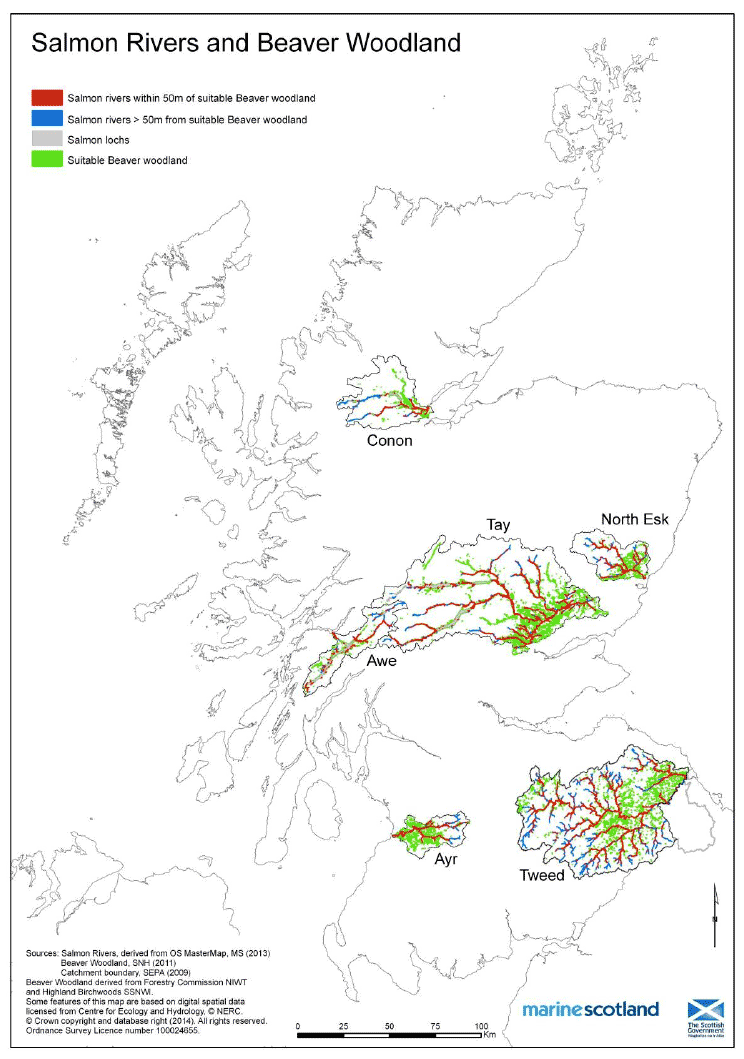
Figure 2. Maps showing salmon rivers within 50m of suitable beaver woodland in six Scottish river catchments. Figure 2(a) River Ayr, Figure 2(b) River Awe, Figure 2(c) River Tweed, Figure 2(d) River Tay, Figure 2(e) River North Esk, Figure 2(f) River Conon.
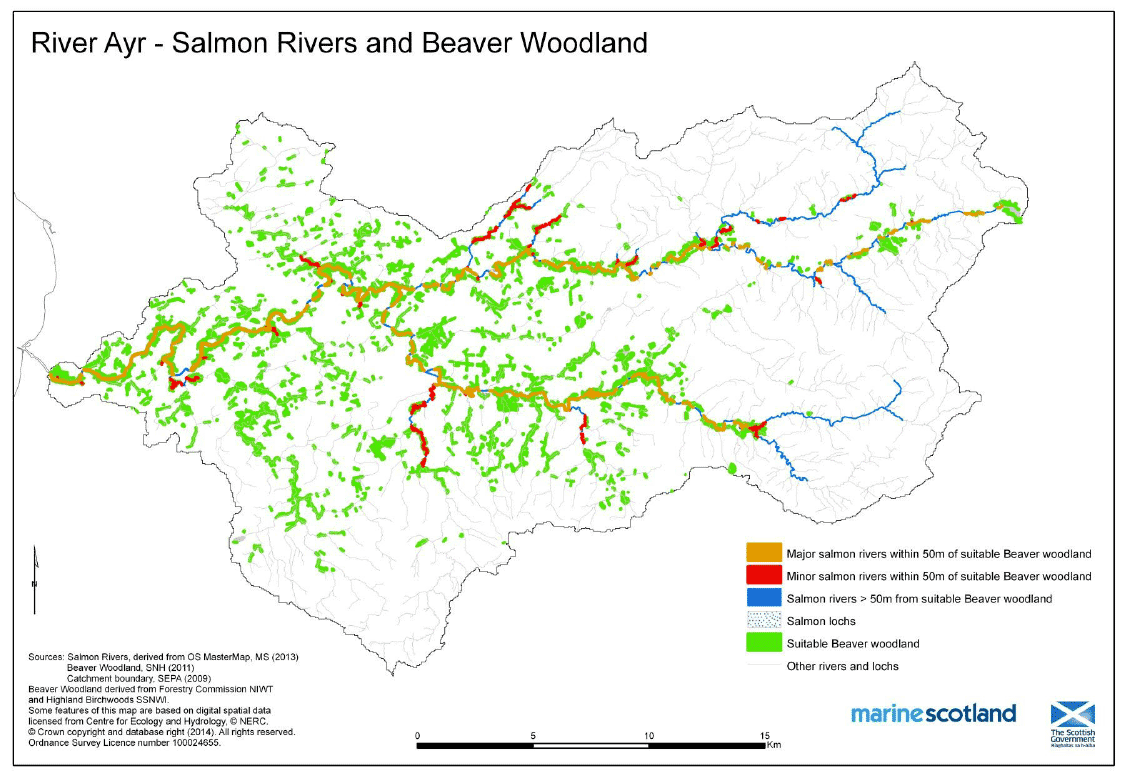
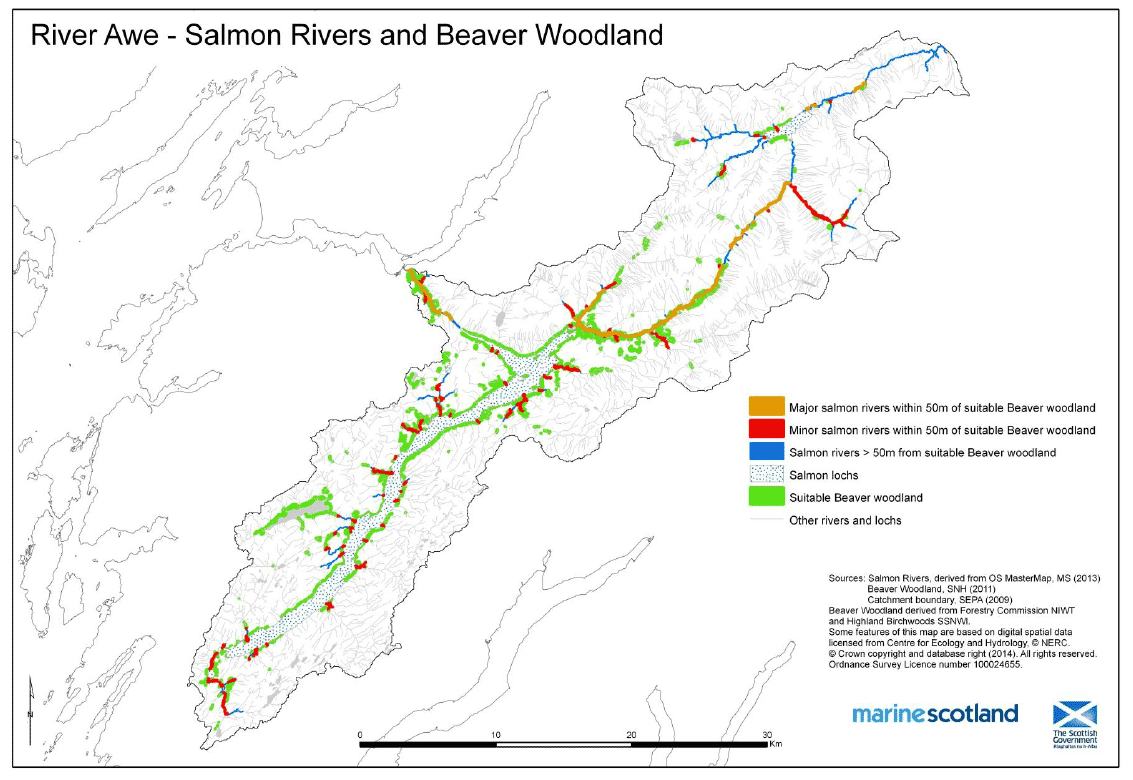
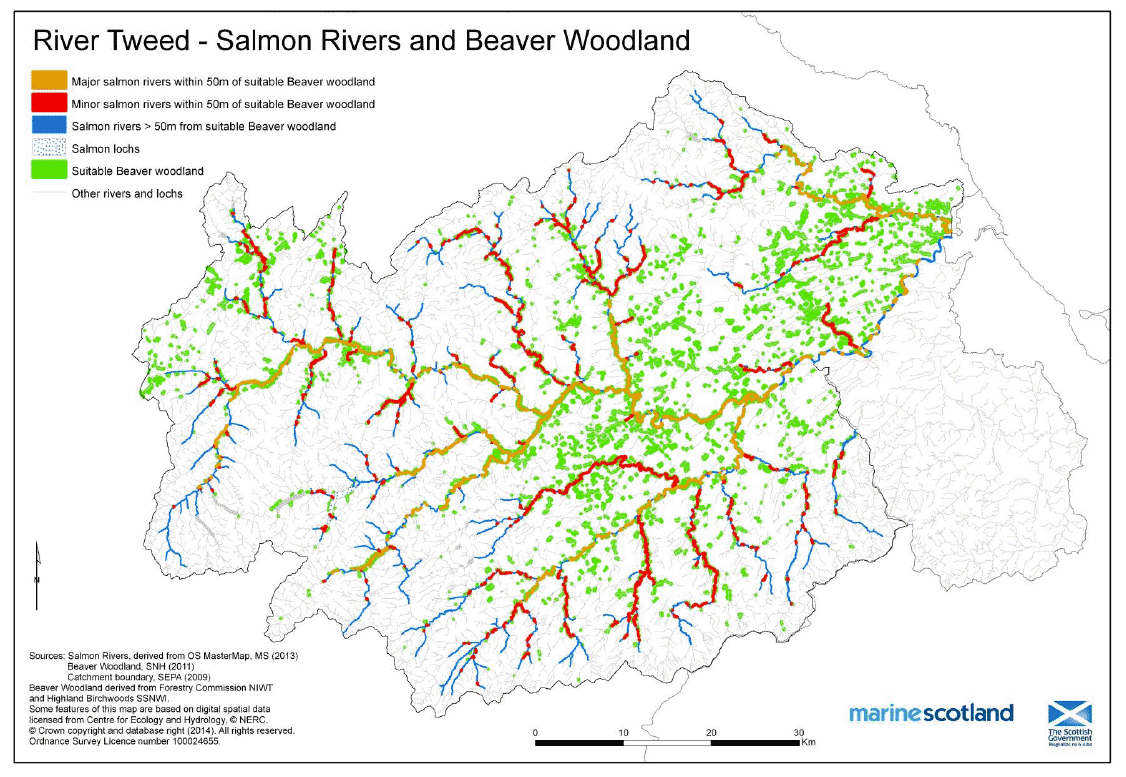

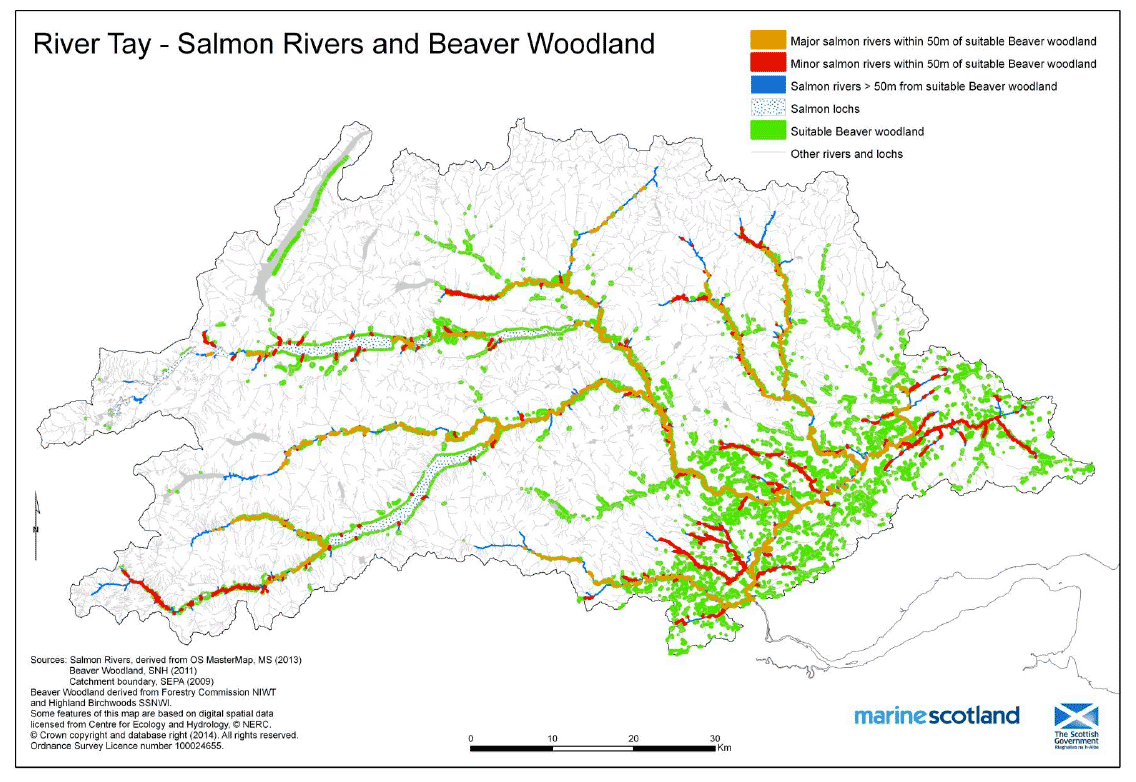
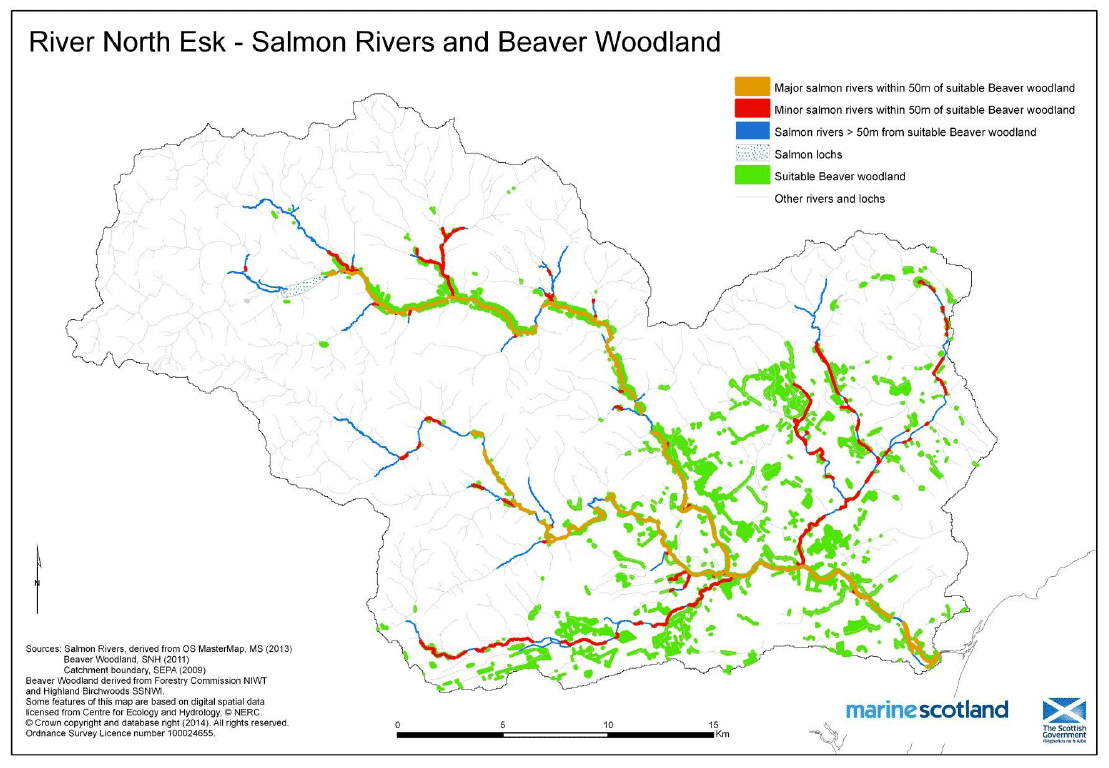
Contact
There is a problem
Thanks for your feedback